Watermelon belongs to the family Cucurbitaceae and is the name of its edible fruit. Watermelon (Citrullus lanatus) is named after its extremely high water content, about 92%. Watermelon needs fertile soil and a long warm growing season to produce good fruit. One of the main reasons why fruits are not sweet and ripe is the lack of heat during ripening.
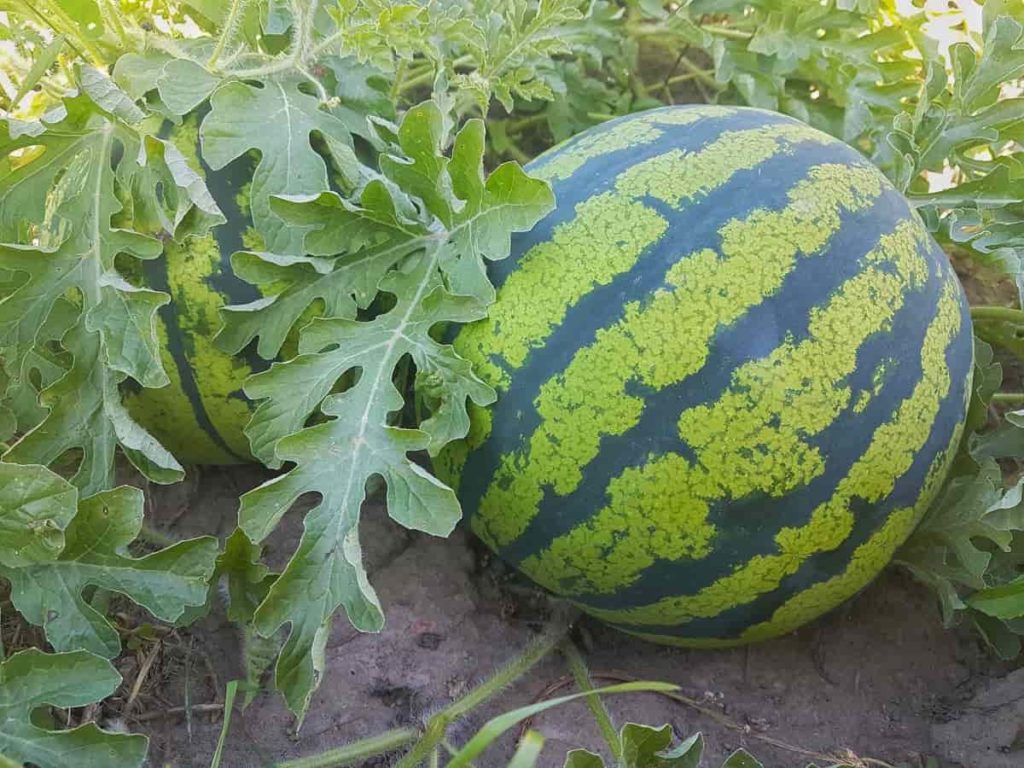
Watermelons are an annual that can be grown in any zone during the summer, but only USDA Zone 4 and above have a long enough season to produce good quality fruit. Like most crops, Watermelon should be planted in a well-drained area, not in a low-lying area susceptible to flooding or on land with poor internal drainage. It takes time, but growing cover crops is a great way to increase organic matter and improve the internal drainage of the field.
What is the best state for growing Watermelon?
Florida has historically been the largest producer of Watermelon, accounting for 19% of the 3.9 billion pounds of US Watermelon production.
Best season for Watermelon farming in USA
The most popular are the seeded, seedless, small, yellow, and orange flesh varieties. The Watermelon season lasts all summer – from May to September – but the exact extent depends on where you live; keep an eye on your local farmer’s market.
Best Watermelon varieties in the USA
More than 1,200 varieties of Watermelon are produced in more than 96 countries worldwide. In the United States and Mexico alone, 200 to 300 varieties are grown, of which 50 are the most popular. A few varieties of Watermelon do well, especially in Florida. If you are thinking of growing a famous smaller, ice box-sized Watermelon, look for varieties like ‘Sugar Baby’ or ‘Mickeylee.’ If you have the space and the desire to grow large Watermelons, look for ‘Jubilee’ (Florida Giant), ‘Crimson Sweet’, or ‘Charleston Grey 133’.
Florida produces both seeded and seedless Watermelons, but seedless melons now dominate the market. Watermelon-seeded varieties available in Florida include ‘Estrella’, ‘Jamboree’, ‘Mardi Gras’, ‘Sangria’, ‘Sentinel’, ‘Stargazer’, ‘Summer Flavor 790’, ‘Summer Flavor 800’, and “Top Gun’. Seedless Watermelon varieties are ‘Captivation,’ ‘Crunchy Red,’ ‘Fascination’, ‘Joy Ride’, ‘Kingman’, ‘Melody’, ‘Sugar Fresh’, ‘Sweet Polly’, ‘TriX313’, ‘Troubadour’, and ‘7187 HQ’.
Temperature requirement for Watermelon growth
Watermelon plants thrive best when the daytime temperature is between 21 and 29°C, although they can handle daytime temperatures up to 32°C. With that in mind, the best time to plant Watermelon will depend on where you are in the state. People in North Florida in March and April, and then Watermelon can be planted in July and August.
Central and South Florida gardeners can plant early in the year, where warm spring temperatures make January to March ideal for planting. In Central Florida, Watermelons can be replanted in August, and South Florida in August and September.
Watermelon production in the USA
According to the USDA, approximately the USDA produced 40.1 million pounds of Watermelons. Recently, seedless Watermelons have surpassed seeded Watermelons in production as the seedless varieties are in high demand by consumers.
Most US Watermelons are grown in Texas, California, Georgia, or California. Although most Watermelons used in the United States are produced locally, about a quarter of the US market is imported from Mexico or Central American countries. Worldwide, the United States ranks seventh in total Watermelon production.
In case you missed it: Top 20 Steps to Boost Watermelon Yield: How to Increase Fruit Size, Quality, and Production
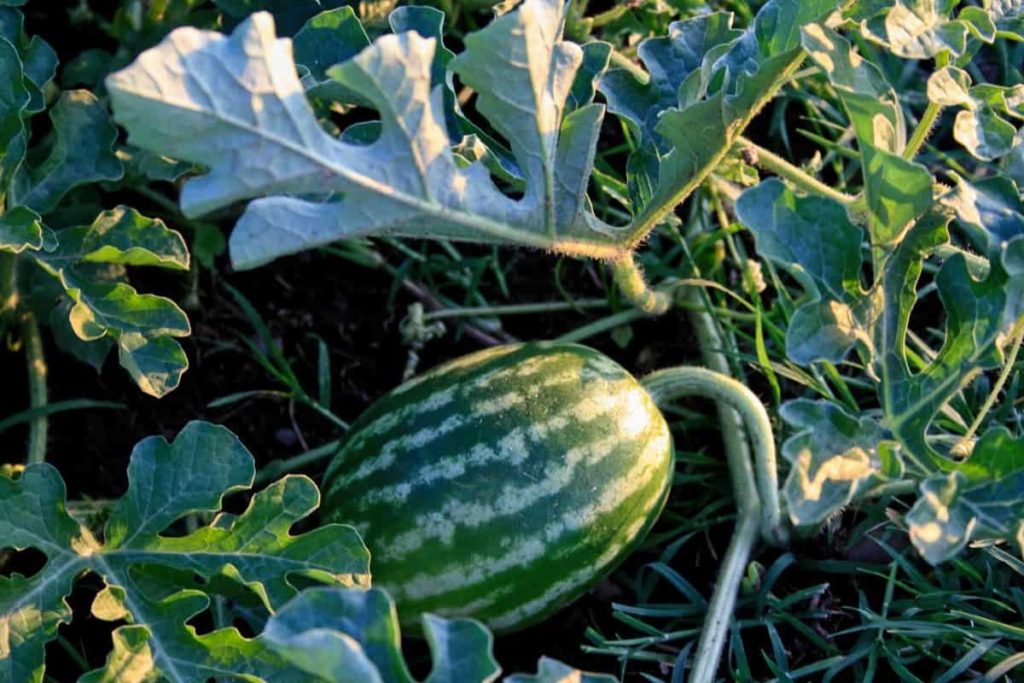
Soil conditions for Watermelon farming
Select warm, well-drained, organic matter soils with a pH of 6.5 to 7.5. Constant, abundant moisture is needed until the fruit is the size of a tennis ball. Consider using black plastic and fabric row covers to accelerate soil heat. Sandy or lightly textured soil that warms up early in the spring is best. To maintain ideal soil conditions, winter cover crops help protect the soil by reducing compounds and adding organic matter.
Since sandy soils require more frequent and light irrigation than heavy soils, drip irrigation is a common method of watering Watermelon plants to ensure uniform water and moisture. With field irrigation, soil moisture should not be less than 50%. Watermelons without seeds contain sterile pollen, so it is essential to use seeded Watermelon to provide pollen.
Most polishing strategies involve planting a pollinizer in every third row to provide enough pollen to seedless Watermelons. Applying these rows of pollinators will later stimulate the growth of Watermelon fruit. Both Watermelons without seeds and polarizing seeds will be harvested and sold, so the polarizer rows are marked so they can be separated from the triploid varieties.
Light requirement for Watermelon farming
Watermelon needs full sunlight to thrive. Plants can tolerate some partial shade, especially in hot weather, but plenty of sunlight is essential for the growth of sugar in melons. Excessive shady conditions will reduce the number and size of fruits.
Watermelon farming states in the USA
Florida, Georgia, Texas, California, and Arizona are the largest watermelon-producing countries in the United States. Florida produces more Watermelons compared to any other state. This common fruit is now so large that the grocery store often sells half or a quarter of melons. About 80% of all US Watermelon production comes from the four states of Florida, Georgia, Texas, and California.
Florida surpasses all other states as a major supplier to the United States. While Watermelons are grown throughout the United States, the highest production is in the top five states (Arizona, California, Delaware, Florida, and Texas), which account for about 69% of all Watermelons grown in the United States.
In terms of production, Watermelon is one of the top three crops grown in the United States, along with onions and lettuce. About 24% of the Watermelon’s domestic consumption comes from American farmers. The rest come mainly from Mexico or Central American countries.
Watermelon care and maintenance
- If you have a long, hot growing season, plant the seeds directly in the garden. To ensure ripening in short growing seasons and colder climates, choose fast-ripening, small-fruited crops, plant indoors, and use black plastic to warm the soil and protect the plants. Use mulch and fabric row covers.
- When the soil is 21°C or warmer, sow directly 1 to 2 weeks after the average last frost. Plant ½ inch deep, six seeds per hill, 3 feet apart on each path for bush species, or 3 feet apart in rows 8 feet apart for vining varieties.
- For transplanting, sow the seeds indoors ¼ inch deep in peat pots, 2 to 4 weeks before they emerge. After two weeks of average last frost, three plants per hill, 3 feet apart in the hills for bush species, or 3 feet apart in rows at 8 feet distance for grape varieties. Transplants are delicate. Retain soil when transplanting.
In case you missed it: Organic Watermelon Farming, Growing Practices
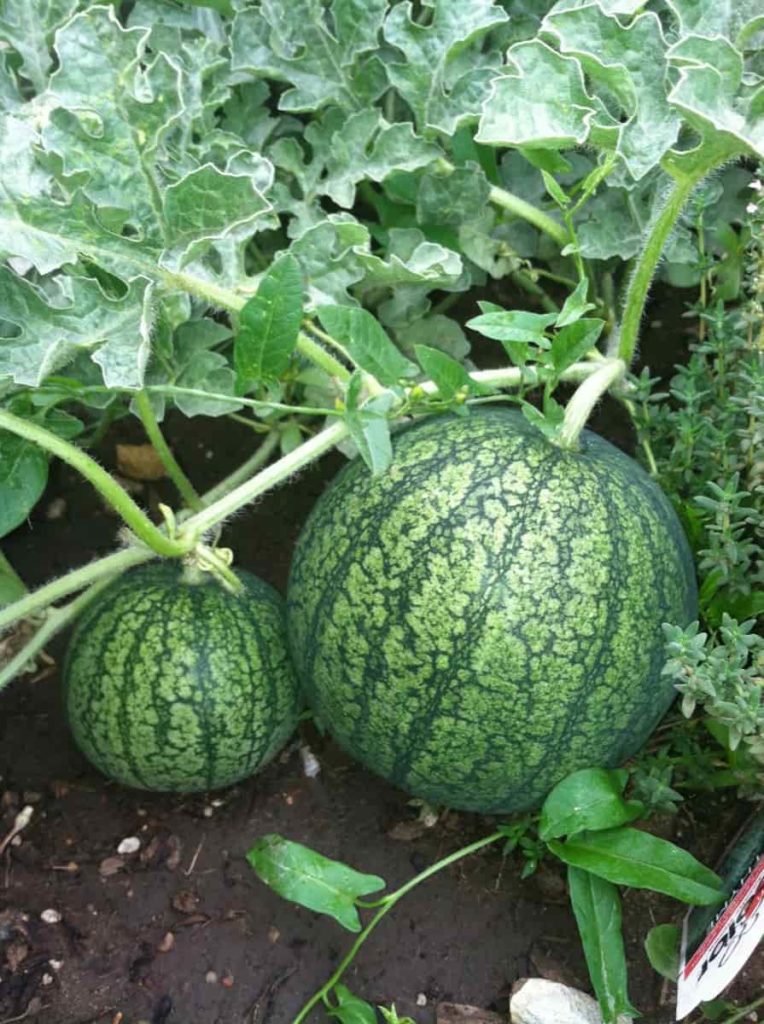
- Planting mulch after the soil warms up helps retain moisture and suppress weeds. If using a fabric row cover, remove it when flowers arrive to allow pollination by bees. Good pollination is essential for fruit sets.
- Plants need constant moisture until pollination. Once the fruit is the size of a tennis ball, water it only when the soil is dry, and the leaves show signs of wilting. To prevent pests from damaging the developing fruit, place the Watermelon on pots or pieces of wood.
- If melons are to be grown on the trails, support the fruit with a sling made of gauze, fabric, or pantyhose. Trellising improves air circulation around plants and can help reduce plant disease problems. Choose smaller fruit varieties and reduce the distance between plants.
- When planting Watermelons, you can plant seeds or transplants. Just be careful with transplants, as Watermelon roots are sensitive. Look for transplants grown in peat pots that can be planted directly into the ground. It can help prevent stress in the young roots.
Watermelon production in the USA
The US Agriculture Department recommends using at least one bee hive per acre (4,000 m2 per hive) to pollinate traditional seed varieties for commercial planting. Hybrids without seeds have sterile pollen. It requires the application of pollinizer rows of viable pollen types.
As the supply of viable pollen decreases and pollination is critical for seedless variety production, the recommended pollinator density increases to three hives (1,300 m2 per hive). Watermelons have a longer growth period than other melons and can often take up to 85 days or more from transplanting to ripening.
Nutrient requirements for Watermelon farming
Nitrogen, phosphorus, and potassium can be considered two options. Short-term varieties can be supplemented with 50:40:50 kg/acre and long-term varieties with 65:50:65 kg/acre / crop. Watermelon plants are heavy feeders. Make sure your soil is well-modified with organic matter before planting. If your soil is deficient in organic matter, apply organic fertilizer at the beginning of the season.
To keep the Watermelon growing, side dress with a layer of fertilizer in the middle of the season. If you use chemical fertilizers, apply a fertilizer with more nitrogen than phosphorus and potassium, as it will promote leaf and vine growth. But after flowering begins, fertilize a second time with a low-nitrogen fertilizer that encourages flower and fruit growth.
Watermelon farming in Florida
Florida is a leading producer of Watermelons and is a favorite on Florida’s harvest calendar from April to July this summer. Although it is generally considered a summer fruit, Florida growers are lucky enough to be able to harvest Watermelons in the winter. Florida is the state in the country that produces more Watermelon fruits from December to April.
Watermelon farming in New York
Heat-loving Watermelons growing in the colder parts of New York can be challenging. To maximize success, choose short-season varieties, start them from the inside out, warm the soil with black plastic mulch, and protect the young plants with rows of cloth.
Does Watermelon grow in Ohio?
Watermelons prefer to grow in sandy loam soil. However, the soil conditions are not ideal in all parts of the country. In Ohio, many areas are clay-heavy. High beds or planting rows are often used to grow Watermelons.
Pests and diseases management
Striped or spotted cucumber beetles – Make fine mesh or cheesecloth tents or use floating row cover on young plants. Keep in place when planting and remove when flowering—control beetles to prevent bacterial wilt.
Aphids – A hard stream of water can be used to remove aphids from Watermelon plants. Check for evidence of the presence of natural enemies such as gray-brown or bloated parasitic aphids and the alligator-like larvae of the Lady Beetles and Lace Wings.
In case you missed it: Watermelon Seed Germination, Time, Temperature, Process
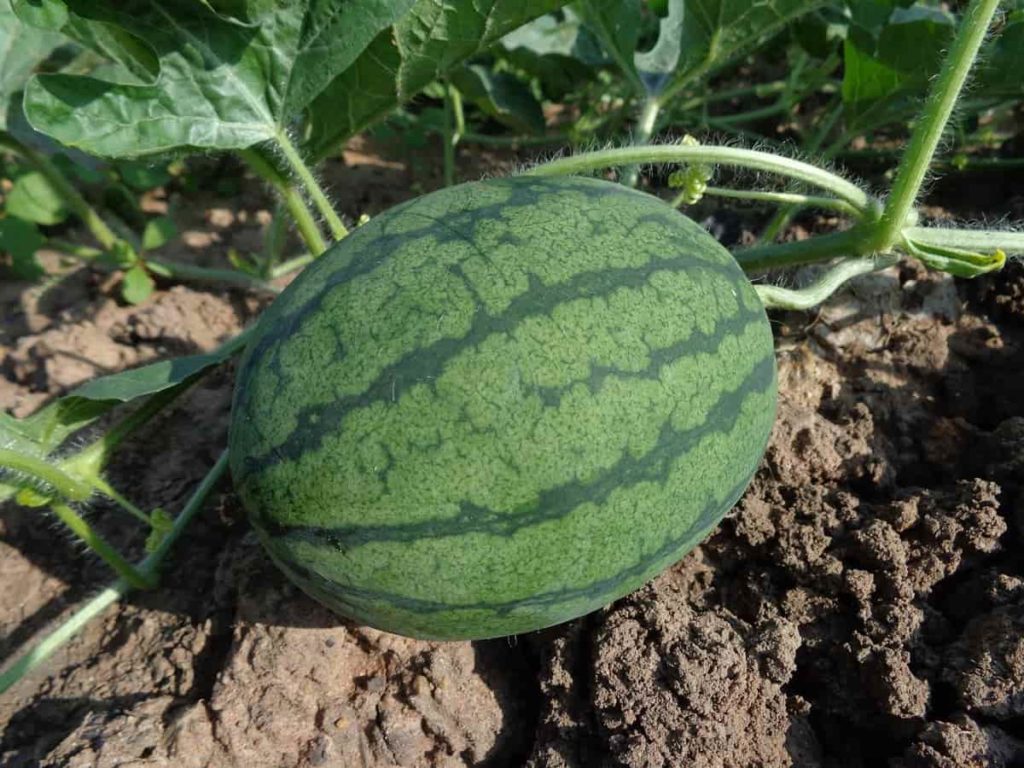
Squash vine borer – Cut and remove open vine by hand.
Flea Beetles – Use row cover crops to help protect plants from early pest damage. Keep in place when planting and remove when flowering—control weeds.
Powdery mildew – Avoid wetting plants if possible. Water early in the day so that the tops of the plants dry out as soon as possible. Avoid crowded plants—separate space to allow air circulation. Eliminate weeds around the plants and garden to improve air circulation.
Cucumber Mosaic Virus – Remove and destroy infected Watermelon plants. Please get rid of cucumber beetroot and aphids as soon as they appear.
Scab – Avoid wetting foliage if possible. Water early in the day so that the tops of the plants dry out as soon as possible. Avoid crowded plants—different places for air circulation.
Fusarium wilt – Locate new plants in a different garden section from last year’s location. Plant-tolerant varieties.
The biggest pest of Watermelon is the cucumber beetle. Monitor eggs quickly. If you use a row cover, you will remove many of them from the vines. Watermelons are also infested with aphids and mites. Many diseases, including Fusarium wilt, anthracnose, Alternaria leaf spot, and gummy stem spots, can be a problem. If these diseases are common, then choose watermelon-resistant varieties. Ground-level water instead of overhead watering will prevent soil spores from splashing on the leaves and causing mildew.
Watermelon growing tips
- Watermelons rely on bees for pollination, so avoid using pesticides and take steps to attract them. It includes planting nearby flowering herbaceous species, such as clover and lavender.
- To increase the size of the fruit, remove the lateral vines from the main stem. For the largest fruit, pinch most of the flowers so that there are only two or three fruits per plant.
- If a black plastic mulch is not used, lift a piece of cardboard, a wooden plank, or a handful of straw from the soil beneath the fruit – this will prevent the fruit from rotting.
Irrigation requirement for Watermelon farming
Irrigation plays an important role in keeping vines healthy and delicious fruits. Vines are most susceptible to drought, from planting to fruiting. Drip irrigation delivers water directly to the soil, helping to prevent the possible spread of fungal diseases in wet plants. Keeping the soil moist but not full of water will kill the plants. It is common for leaves to wither in the midday sun, but they should not wither until evening. Water the grapes early in the morning so the leaves dry out before sunset, which will further help prevent fungal diseases.
During the fruiting stages, and as the temperature rises considerably, they increase the irrigation season due to the expansion requirements of the plants in these stages. Eventually, they dramatically reduce irrigation and almost stop irrigation in the final stages of maturation. Too much water in these stages will cause the fruit to explode. In some states in the USA, commercial Watermelon growers provide an average of 25mm of water per week.
In case you missed it: Watermelon Profits, Yield Per Acre, Growth Stages
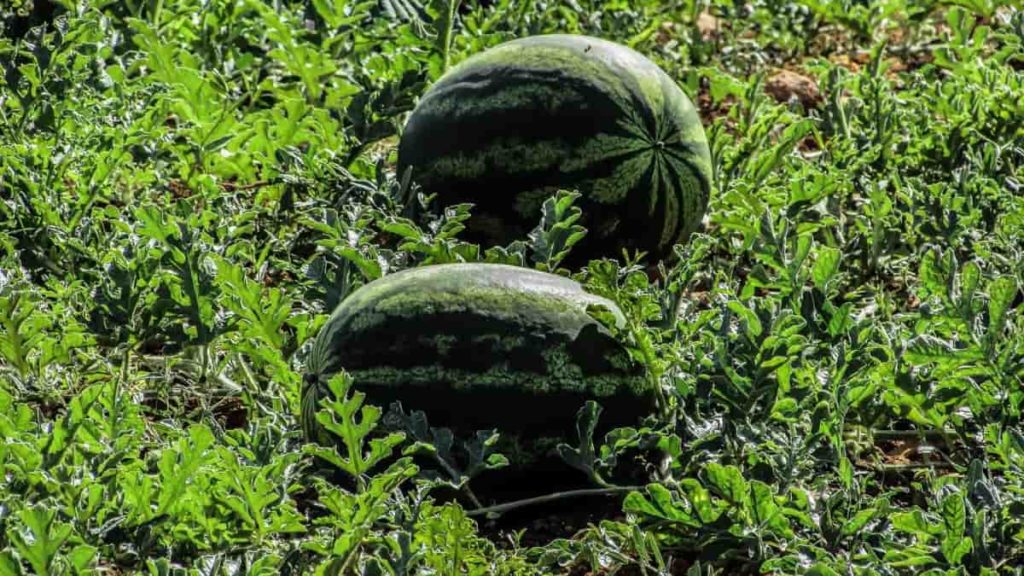
Many producers prefer to water their Watermelon early in the morning during the first stage and late in the evening with an increase in temperature. Watermelons usually require more water, but watering plants is linked to spreading disease. Generally, high humidity favors the growth of pathogens such as powdery mildew. On the other hand, water-pressure plants are more susceptible to diseases. The most widely used irrigation system in Watermelon farming is drip irrigation. Irrigation is carefully managed during growth to improve fruit size and yield.
Watermelon pollinating procedures
The Watermelon fruit set depends on the activity of bees and other beneficial insects that distribute pollen. Especially when we grow varieties without seeds, it is important to have 1 or 2 strong and healthy hives per 1 hectare. If we grow Watermelons indoors or our area’s natural population of bees is not large enough to pollinate our plants, then manual pollination may be an option.
When and how to harvest Watermelon
Time varies depending on the Watermelon type, usually between 70 and 90 days. In general, smaller varieties take less time to mature than larger varieties. Seedless Watermelon varieties usually fall at the end of this range, taking 80 to 85 days to reach maturity. Watermelon is considered the best to eat when the flesh has a sweet taste, crisp texture, and deep red color.
Sugar content is an important factor for consumers, so melons can be selected from the field and tested for sugar content through a hand refractometer to assess the ripeness of the field. Signs of a ripe Watermelon include withering bulls, yellowing of the ground, the sound of a soft hollow slap, and the breaking of a green band with stripes on the sides of the Watermelon.
Watermelons for distant markets are usually picked before ripening to minimize meat spoilage. Watermelons are cut by hand, but they should be handled sparingly to minimize damage to the skin. When they are ready to be harvested, they usually see a yellow spot on their skin that is in contact with the soil. Furthermore, observe a dry tendril on the part to which the trunk is loosely attached.
Due to the difference in the time of germination, not all Watermelons ripen at the same time. That way, we may have to mow more than once in the same field. Watermelons can only be cut by hand. We must be careful not to cut or pull the Watermelon; otherwise, the fruit may break, and they cannot be marketed in such a case.
Watermelon marketing in the USA
Watermelons are grown for fresh markets. Large-scale producers (over 20 acres) typically use brokers who provide marketing services to producers. Watermelons are grown for fresh markets. Large-scale producers (over 20 acres) typically use brokers who provide marketing services to producers.
Florida, Georgia, Texas, Arizona, and California are the major Watermelon producing states, accounting for about 44% of US Watermelon production. Seedless Watermelon (triploid hybrid cultivars) has been the main commercially grown variety for the US market, accounting for 85 percent of total Watermelon shipments in the United States.
Preferred diseases identified by United States Watermelon producers include Fusarium wilt, Gummy stem blight, Phytophthora fruit rot, Powdery mildew, Cucumber green motel mosaic virus, and the Watermelon strain of papaya ringspot virus.
In case you missed it: Watermelon Farming, Cultivation Information Guide
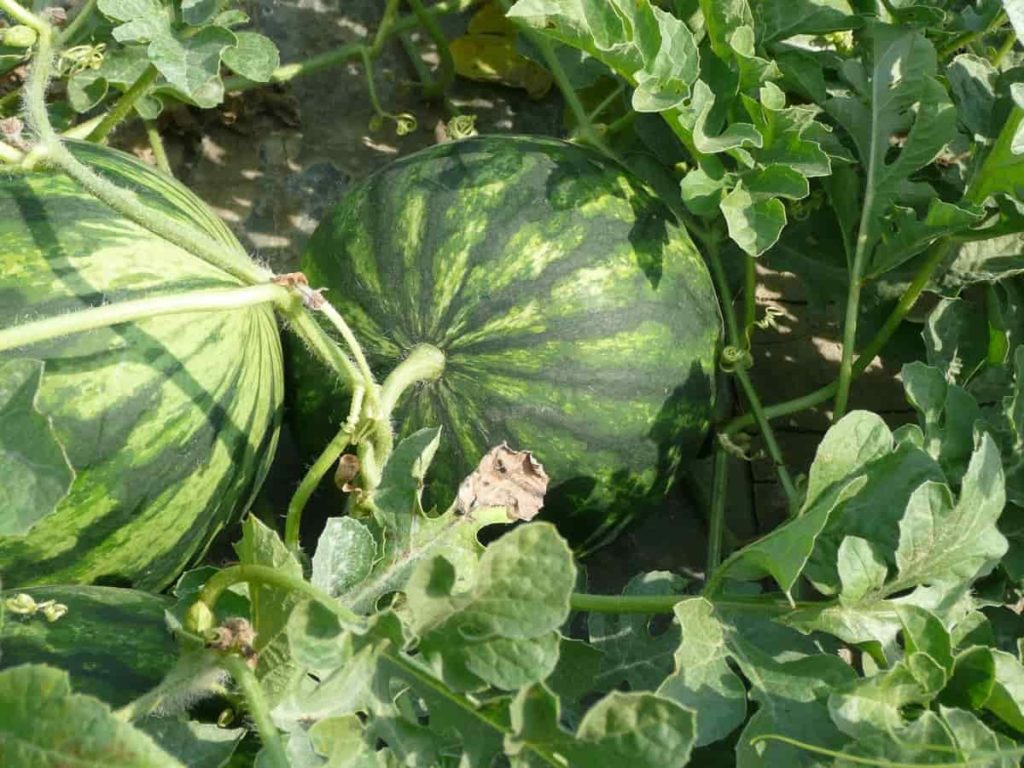
Watermelon yield in the USA
Florida ranks first nationally in Watermelon production, accounting for 25.1% of total US production, 29.6% of total US crop value, and 24.7% of the national Watermelon acreage. The average yield of Watermelon in the United States is 39,704 pounds per acre.
Conclusion
Watermelon consumption and production in the United States have increased over the past few decades. Watermelon farming is a profitable business in the USA. The above information helps get more Watermelon production in the United States.
- How to Make Houseplants Bushy: Effective Tips and Ideas
- Innovative Strategies for Boosting Coconut Pollination and Yield
- Pollination Strategies for Maximum Pumpkin Yield
- The Complete Guide to Chicken Fattening: Strategies for Maximum Growth
- Natural Solutions for Tulip Problems: 100% Effective Remedies for Leaf and Bulb-Related Issues
- Revolutionizing Citrus Preservation: Towards a Healthier, Greener Future
- Natural Solutions for Peony Leaf and Flower Problems: 100% Effective Remedies
- Maximizing Profits with Avocado Contract Farming in India: A Comprehensive Guide
- Natural Solutions for Hydrangea Problems: 100% Effective Remedies for Leaf and Flowers
- The Ultimate Guide to Choosing the Perfect Foliage Friend: Bringing Life Indoors
- From Sunlight to Sustainability: 15 Ways to Use Solar Technology in Agriculture
- The Ultimate Guide to Dong Tao Chicken: Exploring from History to Raising
- The Eco-Friendly Makeover: How to Convert Your Unused Swimming Pool into a Fish Pond
- Mastering the Art of Delaware Chicken Farming: Essentials for Healthy Backyard Flocks
- 20 Best Homemade Fertilizers for Money Plant: DIY Recipes and Application Methods
- How to Craft a Comprehensive Free-Range Chicken Farming Business Plan
- Brighten Your Flock: Raising Easter Egger Chickens for Beauty and Bounty
- How to Optimize Your Poultry Egg Farm Business Plan with These Strategies
- Subsidy for Spirulina Cultivation: How Indian Government Schemes Encouraging Spirulina Farmers
- Ultimate Guide to Raising Dominique Chickens: Breeding, Feeding, Egg-Production, and Care
- Mastering the Art of Raising Jersey Giant Chickens: Care, Feeding, and More
- Ultimate Guide to Raising Legbar Chickens: Breeding, Farming Practices, Diet, Egg-Production
- How to Raise Welsummer Chickens: A Comprehensive Guide for Beginners
- How to Protect Indoor Plants in Winter: A Comprehensive Guide
- Ultimate Guide to Grow Bag Gardening: Tips, Tricks, and Planting Ideas for Urban Gardeners
- Guide to Lotus Cultivation: How to Propagate, Plant, Grow, Care, Cost, and Profit
- Agriculture Drone Subsidy Scheme: Government Kisan Subsidy, License, and How to Apply Online
- Ultimate Guide to Raising Araucana Chickens: Breed Profile, Farming Economics, Diet, and Care
- Bringing Hydroponics to Classroom: Importance, Benefits of Learning for School Students
- Ultimate Guide to Raising Polish Chickens: Breed Profile, Farming Economics, Diet, and Care
- Ultimate Guide to Raising Australorp Chickens: Profile, Farming Economics, Egg Production, Diet, and Care
- Silkie Chicken Farming: Raising Practices, Varieties, Egg Production, Diet, and Care
- Sussex Chicken Farming: Raising Practices, Varieties, Egg Production, Diet and Care
- Homemade Feed Formulations for Livestock: Discover Cost-effective Starter to Finisher Feed Recipes
- 20 Best Pig Weight Gain Supplements: Top Swine Weight Gain Formulas
- Ultimate Guide to Elderberry Farming: Propagation, Planting, Yield, Cost, and Profit